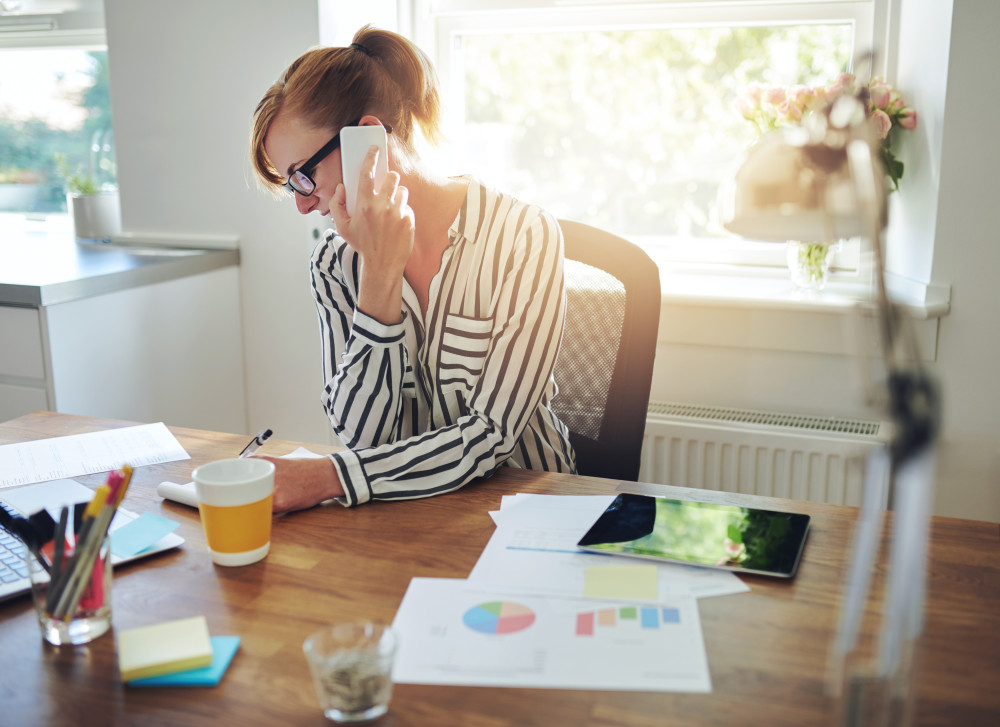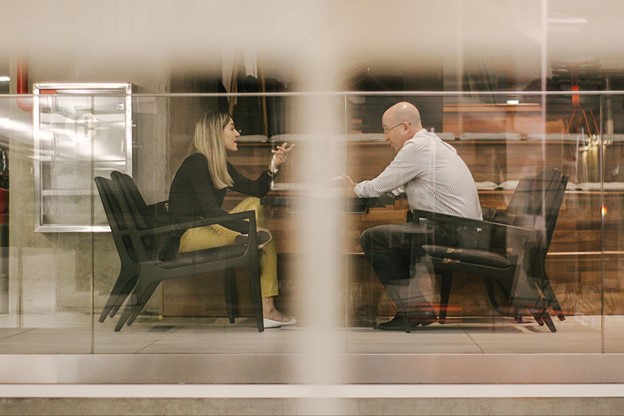Has setting up your home office during COVID-19 virus been a headache? If productivity has been an issue for you, I’ll share some organizing and time management hacks that will make a huge impact on your work.
What people working at home don’t realize: everyone has an inner productivity circle.
In fact, if you think about your home office as a series of circles radiating away from you (like the parallel ripples that radiate out when you drop a rock into a still pool of water), you’ll realize that what you keep close to you is important.

Concentric Productivity Circles
I first learned about this concept from my organizing mentor, Porter Knight. She talks about it in her book, Organized to Last. In it, she coined the term ‘concentric circles’.
I recently taught this productivity principle at a lunch and learn for a large local company. Several people were blown away by this principle; the idea that your work output increases when you only keep frequently used items within arms’ reach.
It makes total sense to me, if you spend less time getting up to use tools in the office, your workday will be more efficient. I will illustrate.
Circle 1: For me, the tools I use every day several times a day need to be in my inmost work circle of my home office. I should not have to roll my chair or even swivel it to get the items I use more than twice a day.
Items in my inner productivity circle: computer, mouse, planner or to-do list, pens, Post-its, stapler, tape, tool drawer, timer, hand lotion, drawer of important files, and trash can.
You may need additional tools like a 10-key, calculator, or specialized items for the work you do.
Circle 2: The next layer for efficient work at home would contain tools and resources you might use once a day. For example: file drawers, your tissue box, projects file, business card binder, cork board or whiteboard, speakers, etc.

Circle 3: The Third layer, the one farthest from you, would have things like resource books, archived files, office supply storage, camera equipment, supplies you travel to clients with, a briefcase or bag for networking events, etc. This layer holds supplies or archives used occasionally or rarely.
When I work with a client, we concentrate on creating open space around them in their home office, The problem with most work spaces is they have TOO MUCH STUFF cluttering their inner circle. this is true for many who are working at home.
Stuff that clutters up our desks: papers that need to be filed, projects, ideas, mail, Post-its, business cards, books, food, and personal items unrelated to your work or comfort are some of the clutter.
Did you know that clutter actually distracts from your work? Visual clutter, like stacks of paper, magazines, or too much in your inbox contribute to a state of low-level anxiety for some people.
Watch what happens when you clear off all the clutter from your desk and floor in your home office. I know every time I put all my papers away in files or project binders, I feel a rush of energy and am motivated to tackle the most important task of the day. Try it, you’ll like it!
Some people I’ve worked with are comfortable with one pile of work on their desk or a large inbox, and that’s fine. The important thing is to find what works best for you.
Everyone has their clutter threshold.
To help you even more, I’ll share a list of tips for staying productive while working at home. Time management tips like these are sorely needed in these unprecedented times when all the kids are home attending virtual classes because of COVID.
10 Secrets to Get More Done in Your Home Office
Tip 1: Focus Time
Figure out what your best focus time is. Do the work that requires the most brainpower then. If you’d like to pinpoint the time of day, email me and I will send you a quiz that will show you when you do your best work! jennym@efficientspacesco.com
Tip 2: Limit Distractions
If your spouse or kids are home during work hours, make sure they know not to disturb you. Close the doors if you need to. Put on headphones with some music that helps you focus. This has a dual job: to let people know you don’t want to be disturbed, and it keeps you from hearing background noise.
“Ambient sounds, especially with words, occupy about 5-10% of your intellectual bandwidth. By wearing ear protectors, you acoustically isolate yourself. This freed up bandwidth can now be focused on the desired task.
It’s a great deal. Just put on some earmuffs and you become 5-10% smarter.”
~ Peter Rogers, Straight A Stanford and on to Harvard
Tip 3: Plan
To be effective, make a plan for your week and then break it down by the day. I I start out with a ‘dump list’ then transfer the tasks to my planner, which uses a funnel-down system to help me choose which day to put each task. I use my planner for my to-do list, but a notebook or a sticky note works well to identify the most important daily tasks. For most people, having a daily purpose is a huge motivator. It’s satisfying to check those items off when they’re finished! I would be lost without my to do list. Most professionals who excel at time management use some form of a to-do list, whether electronic or paper. *I use the Planner Pad Organizer.
Tip 4: File Emails
With emails, you can take one of 3 actions: File, respond, or delete. Try not to think about it too much! It doesn’t have to be complicated. The general rule of thumb: if it takes 2 minutes, do it now. (From Getting Things Done by David Allen)
Also, have folders for emails or email categories. Organize them by topic, project, or individual names. A person wastes 6 weeks annually searching for lost documents or because of unorganized folders for the one project they need. Be consistent about filing them. It helps so much when you need that information later!
Tip 5: Clear your inbox
Have an inbox for paper, and clear it daily.
Tip 6: Prioritize projects
Have a “hot spot” for today’s most urgent project. Personally, I prefer a clear file folder standing up in a vertical file sorter. My home office file sorter holds 5 files. Also, put your to-do list in plain sight and review it each morning before you start.
Definitely prioritize projects based on their ROI and on the deadline or due date!
Tip 7: Set a timer
If you tend to distract yourself: ahem… yes I do that! I find that setting a timer is very helpful. This works well if you are easily distracted by “bright and shiny” new emails. Say your purpose for opening your email is to write one necessary email and then close the email so you can focus on a project. Set a timer for 15 minutes before you open your inbox to avoid getting “sucked in” by your email. This really works! (I keep my timer within arm’s reach in my home office.)
“One way to boost our will power and focus is to manage our distractions instead of letting them manage us.” ~ Daniel Goleman
Tip 8: Turn off alerts
If texts, incoming emails, Zoom pop-up, or calendar notifications have alerts that distract you when you are trying to focus in your home office, make sure to turn off those alerts for the hour or 90 minutes when your project needs your full attention. (Before you do this, check your calendar to make sure you don’t have a meeting or scheduled phone call.) If you are not sure how to do this, ask a tech-savvy friends! Or link to the article I provide at the end of this post.
Tip 9: Delegate
Delegate email deletion and unsubscribing from sites to your kids or grandkids (it works great!). Also, make sure to limit spam by having good firewalls in place to limit what gets to your inbox.

Tip 10: Scan
For information you want or need to keep, have it scanned by someone you can delegate to (an assistant, tech-savvy son/daughter, grandchild, high school student) and file or organize it into files. Make sure and have the helpers to do it at a time when you’re doing something low-focus, like responding to emails. That way the interruptions with questions won’t affect your productivity in your home office.
Use these 10 tips to achieve more and reach your business goals!
Related posts: 5 ways to keep distractions at bay: https://efficientspacesco.c.wpstage.net/2015/02/5-tips-distractions-bay/
New Habits: you can do anything for 30 minutes: https://efficientspacesco.c.wpstage.net/2014/05/30-minutes/
How to get an extra hour of productivity daily: https://efficientspacesco.c.wpstage.net/2014/02/extra-hour/
How to turn off distracting notifications: http://www.makeuseof.com/tag/5-distracting-desktop-notifications-turn-windows/








